Advanced Construction Project Management Report - BN4400 Module
VerifiedAdded on 2023/01/19
|29
|6337
|64
Report
AI Summary
This report provides a detailed overview of advanced construction project management, focusing on sustainable practices, nanotechnology, automation, and project supply chains. It explores key areas such as sustainable production and manufacturing, including the use of nanotechnology, recyclable materials, and green materials. The report also delves into sustainable design and construction, covering topics like nearly zero-energy buildings, recycling of building materials, deconstruction, and construction waste management. Furthermore, it examines defect analysis, including total quality management systems, lean construction, and the use of technologies like 3D laser scanning and augmented reality. Finally, the report discusses project supply chains, providing definitions and insights into their management. The report is intended to provide a comprehensive understanding of the core issues and challenges regarding the application of advanced construction technologies.
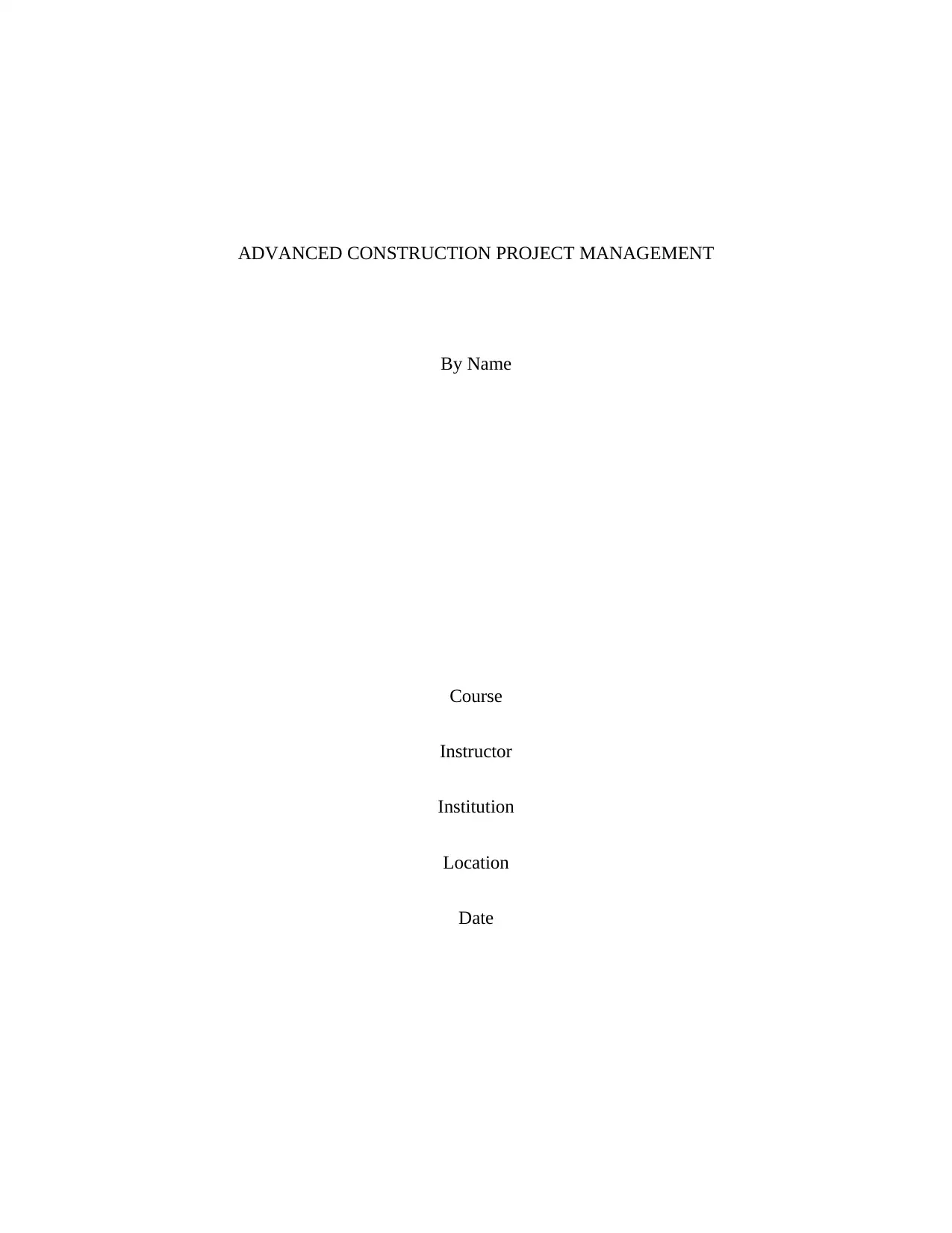
ADVANCED CONSTRUCTION PROJECT MANAGEMENT
By Name
Course
Instructor
Institution
Location
Date
By Name
Course
Instructor
Institution
Location
Date
Paraphrase This Document
Need a fresh take? Get an instant paraphrase of this document with our AI Paraphraser
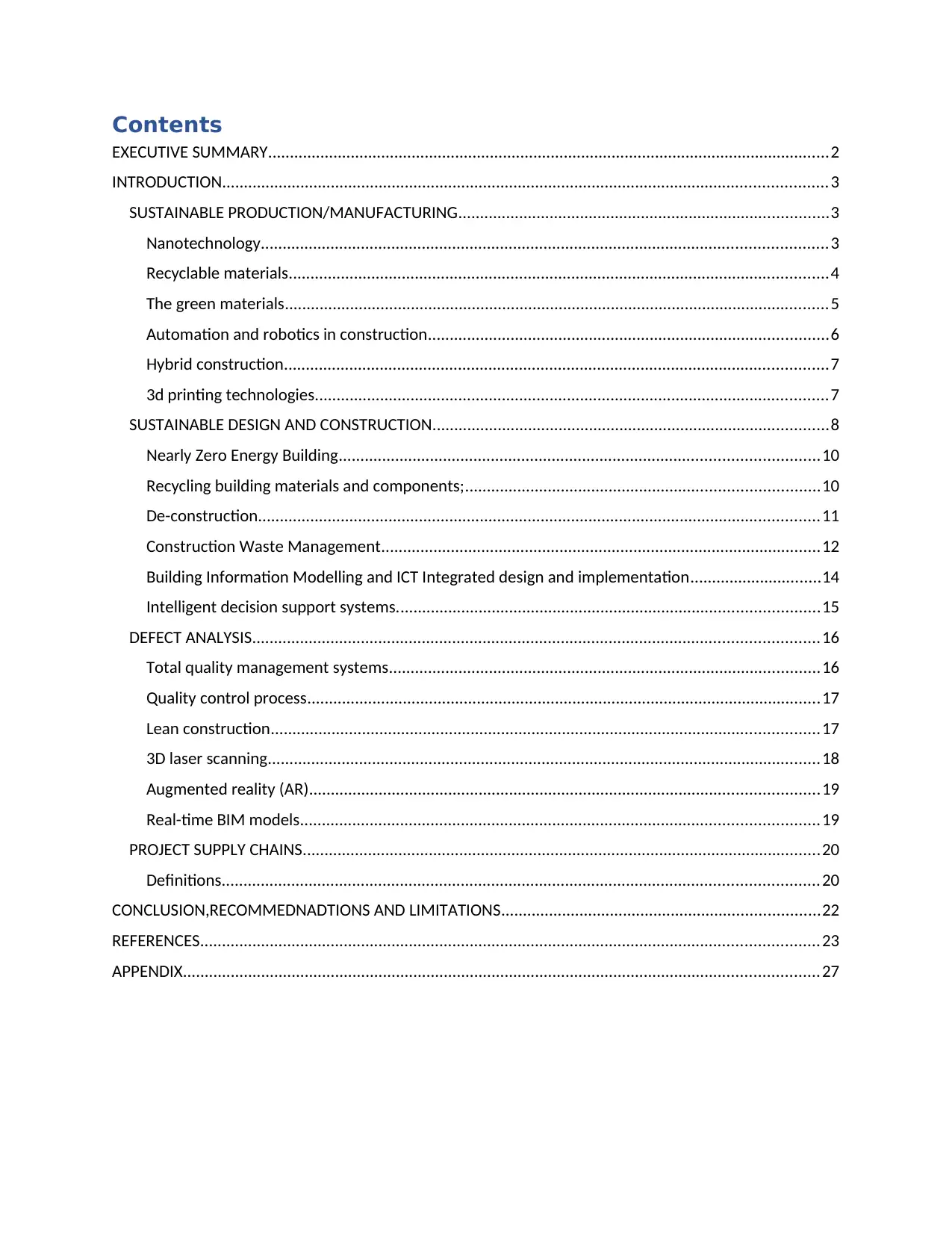
Contents
EXECUTIVE SUMMARY.................................................................................................................................2
INTRODUCTION...........................................................................................................................................3
SUSTAINABLE PRODUCTION/MANUFACTURING.....................................................................................3
Nanotechnology..................................................................................................................................3
Recyclable materials............................................................................................................................4
The green materials.............................................................................................................................5
Automation and robotics in construction............................................................................................6
Hybrid construction.............................................................................................................................7
3d printing technologies......................................................................................................................7
SUSTAINABLE DESIGN AND CONSTRUCTION...........................................................................................8
Nearly Zero Energy Building..............................................................................................................10
Recycling building materials and components;.................................................................................10
De-construction.................................................................................................................................11
Construction Waste Management.....................................................................................................12
Building Information Modelling and ICT Integrated design and implementation..............................14
Intelligent decision support systems.................................................................................................15
DEFECT ANALYSIS..................................................................................................................................16
Total quality management systems...................................................................................................16
Quality control process......................................................................................................................17
Lean construction..............................................................................................................................17
3D laser scanning...............................................................................................................................18
Augmented reality (AR).....................................................................................................................19
Real-time BIM models.......................................................................................................................19
PROJECT SUPPLY CHAINS.......................................................................................................................20
Definitions.........................................................................................................................................20
CONCLUSION,RECOMMEDNADTIONS AND LIMITATIONS.........................................................................22
REFERENCES..............................................................................................................................................23
APPENDIX..................................................................................................................................................27
EXECUTIVE SUMMARY.................................................................................................................................2
INTRODUCTION...........................................................................................................................................3
SUSTAINABLE PRODUCTION/MANUFACTURING.....................................................................................3
Nanotechnology..................................................................................................................................3
Recyclable materials............................................................................................................................4
The green materials.............................................................................................................................5
Automation and robotics in construction............................................................................................6
Hybrid construction.............................................................................................................................7
3d printing technologies......................................................................................................................7
SUSTAINABLE DESIGN AND CONSTRUCTION...........................................................................................8
Nearly Zero Energy Building..............................................................................................................10
Recycling building materials and components;.................................................................................10
De-construction.................................................................................................................................11
Construction Waste Management.....................................................................................................12
Building Information Modelling and ICT Integrated design and implementation..............................14
Intelligent decision support systems.................................................................................................15
DEFECT ANALYSIS..................................................................................................................................16
Total quality management systems...................................................................................................16
Quality control process......................................................................................................................17
Lean construction..............................................................................................................................17
3D laser scanning...............................................................................................................................18
Augmented reality (AR).....................................................................................................................19
Real-time BIM models.......................................................................................................................19
PROJECT SUPPLY CHAINS.......................................................................................................................20
Definitions.........................................................................................................................................20
CONCLUSION,RECOMMEDNADTIONS AND LIMITATIONS.........................................................................22
REFERENCES..............................................................................................................................................23
APPENDIX..................................................................................................................................................27
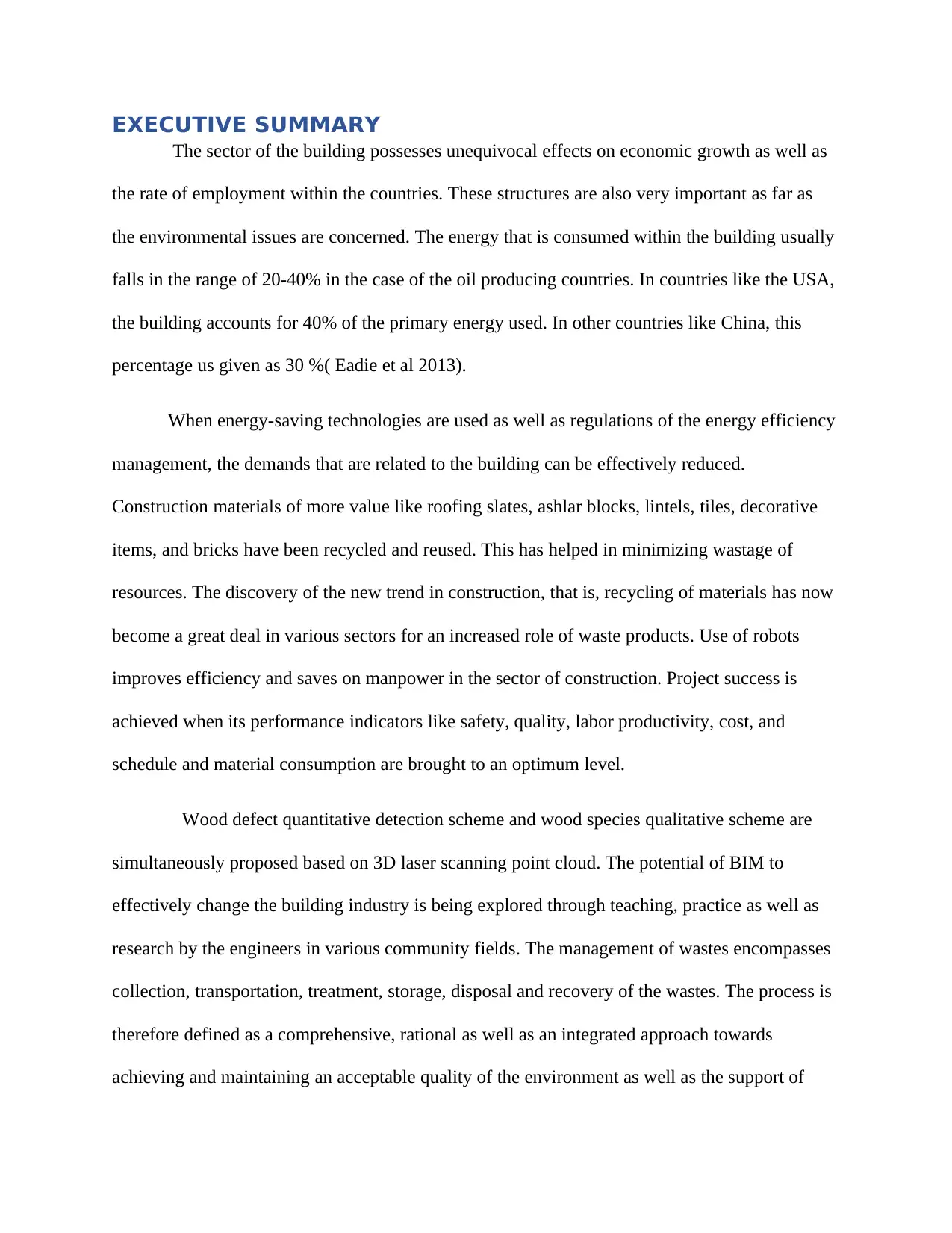
EXECUTIVE SUMMARY
The sector of the building possesses unequivocal effects on economic growth as well as
the rate of employment within the countries. These structures are also very important as far as
the environmental issues are concerned. The energy that is consumed within the building usually
falls in the range of 20-40% in the case of the oil producing countries. In countries like the USA,
the building accounts for 40% of the primary energy used. In other countries like China, this
percentage us given as 30 %( Eadie et al 2013).
When energy-saving technologies are used as well as regulations of the energy efficiency
management, the demands that are related to the building can be effectively reduced.
Construction materials of more value like roofing slates, ashlar blocks, lintels, tiles, decorative
items, and bricks have been recycled and reused. This has helped in minimizing wastage of
resources. The discovery of the new trend in construction, that is, recycling of materials has now
become a great deal in various sectors for an increased role of waste products. Use of robots
improves efficiency and saves on manpower in the sector of construction. Project success is
achieved when its performance indicators like safety, quality, labor productivity, cost, and
schedule and material consumption are brought to an optimum level.
Wood defect quantitative detection scheme and wood species qualitative scheme are
simultaneously proposed based on 3D laser scanning point cloud. The potential of BIM to
effectively change the building industry is being explored through teaching, practice as well as
research by the engineers in various community fields. The management of wastes encompasses
collection, transportation, treatment, storage, disposal and recovery of the wastes. The process is
therefore defined as a comprehensive, rational as well as an integrated approach towards
achieving and maintaining an acceptable quality of the environment as well as the support of
The sector of the building possesses unequivocal effects on economic growth as well as
the rate of employment within the countries. These structures are also very important as far as
the environmental issues are concerned. The energy that is consumed within the building usually
falls in the range of 20-40% in the case of the oil producing countries. In countries like the USA,
the building accounts for 40% of the primary energy used. In other countries like China, this
percentage us given as 30 %( Eadie et al 2013).
When energy-saving technologies are used as well as regulations of the energy efficiency
management, the demands that are related to the building can be effectively reduced.
Construction materials of more value like roofing slates, ashlar blocks, lintels, tiles, decorative
items, and bricks have been recycled and reused. This has helped in minimizing wastage of
resources. The discovery of the new trend in construction, that is, recycling of materials has now
become a great deal in various sectors for an increased role of waste products. Use of robots
improves efficiency and saves on manpower in the sector of construction. Project success is
achieved when its performance indicators like safety, quality, labor productivity, cost, and
schedule and material consumption are brought to an optimum level.
Wood defect quantitative detection scheme and wood species qualitative scheme are
simultaneously proposed based on 3D laser scanning point cloud. The potential of BIM to
effectively change the building industry is being explored through teaching, practice as well as
research by the engineers in various community fields. The management of wastes encompasses
collection, transportation, treatment, storage, disposal and recovery of the wastes. The process is
therefore defined as a comprehensive, rational as well as an integrated approach towards
achieving and maintaining an acceptable quality of the environment as well as the support of
⊘ This is a preview!⊘
Do you want full access?
Subscribe today to unlock all pages.

Trusted by 1+ million students worldwide
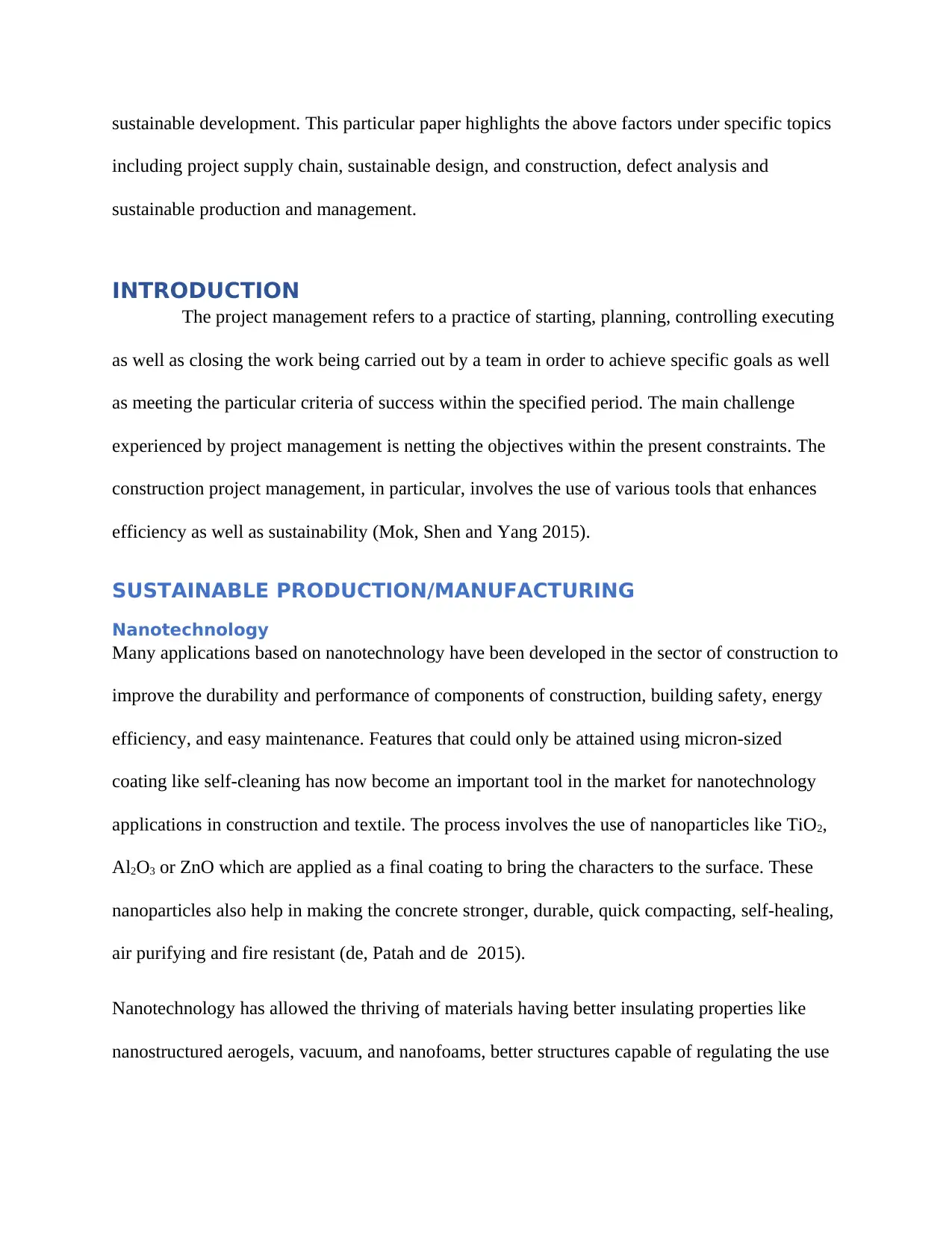
sustainable development. This particular paper highlights the above factors under specific topics
including project supply chain, sustainable design, and construction, defect analysis and
sustainable production and management.
INTRODUCTION
The project management refers to a practice of starting, planning, controlling executing
as well as closing the work being carried out by a team in order to achieve specific goals as well
as meeting the particular criteria of success within the specified period. The main challenge
experienced by project management is netting the objectives within the present constraints. The
construction project management, in particular, involves the use of various tools that enhances
efficiency as well as sustainability (Mok, Shen and Yang 2015).
SUSTAINABLE PRODUCTION/MANUFACTURING
Nanotechnology
Many applications based on nanotechnology have been developed in the sector of construction to
improve the durability and performance of components of construction, building safety, energy
efficiency, and easy maintenance. Features that could only be attained using micron-sized
coating like self-cleaning has now become an important tool in the market for nanotechnology
applications in construction and textile. The process involves the use of nanoparticles like TiO2,
Al2O3 or ZnO which are applied as a final coating to bring the characters to the surface. These
nanoparticles also help in making the concrete stronger, durable, quick compacting, self-healing,
air purifying and fire resistant (de, Patah and de 2015).
Nanotechnology has allowed the thriving of materials having better insulating properties like
nanostructured aerogels, vacuum, and nanofoams, better structures capable of regulating the use
including project supply chain, sustainable design, and construction, defect analysis and
sustainable production and management.
INTRODUCTION
The project management refers to a practice of starting, planning, controlling executing
as well as closing the work being carried out by a team in order to achieve specific goals as well
as meeting the particular criteria of success within the specified period. The main challenge
experienced by project management is netting the objectives within the present constraints. The
construction project management, in particular, involves the use of various tools that enhances
efficiency as well as sustainability (Mok, Shen and Yang 2015).
SUSTAINABLE PRODUCTION/MANUFACTURING
Nanotechnology
Many applications based on nanotechnology have been developed in the sector of construction to
improve the durability and performance of components of construction, building safety, energy
efficiency, and easy maintenance. Features that could only be attained using micron-sized
coating like self-cleaning has now become an important tool in the market for nanotechnology
applications in construction and textile. The process involves the use of nanoparticles like TiO2,
Al2O3 or ZnO which are applied as a final coating to bring the characters to the surface. These
nanoparticles also help in making the concrete stronger, durable, quick compacting, self-healing,
air purifying and fire resistant (de, Patah and de 2015).
Nanotechnology has allowed the thriving of materials having better insulating properties like
nanostructured aerogels, vacuum, and nanofoams, better structures capable of regulating the use
Paraphrase This Document
Need a fresh take? Get an instant paraphrase of this document with our AI Paraphraser
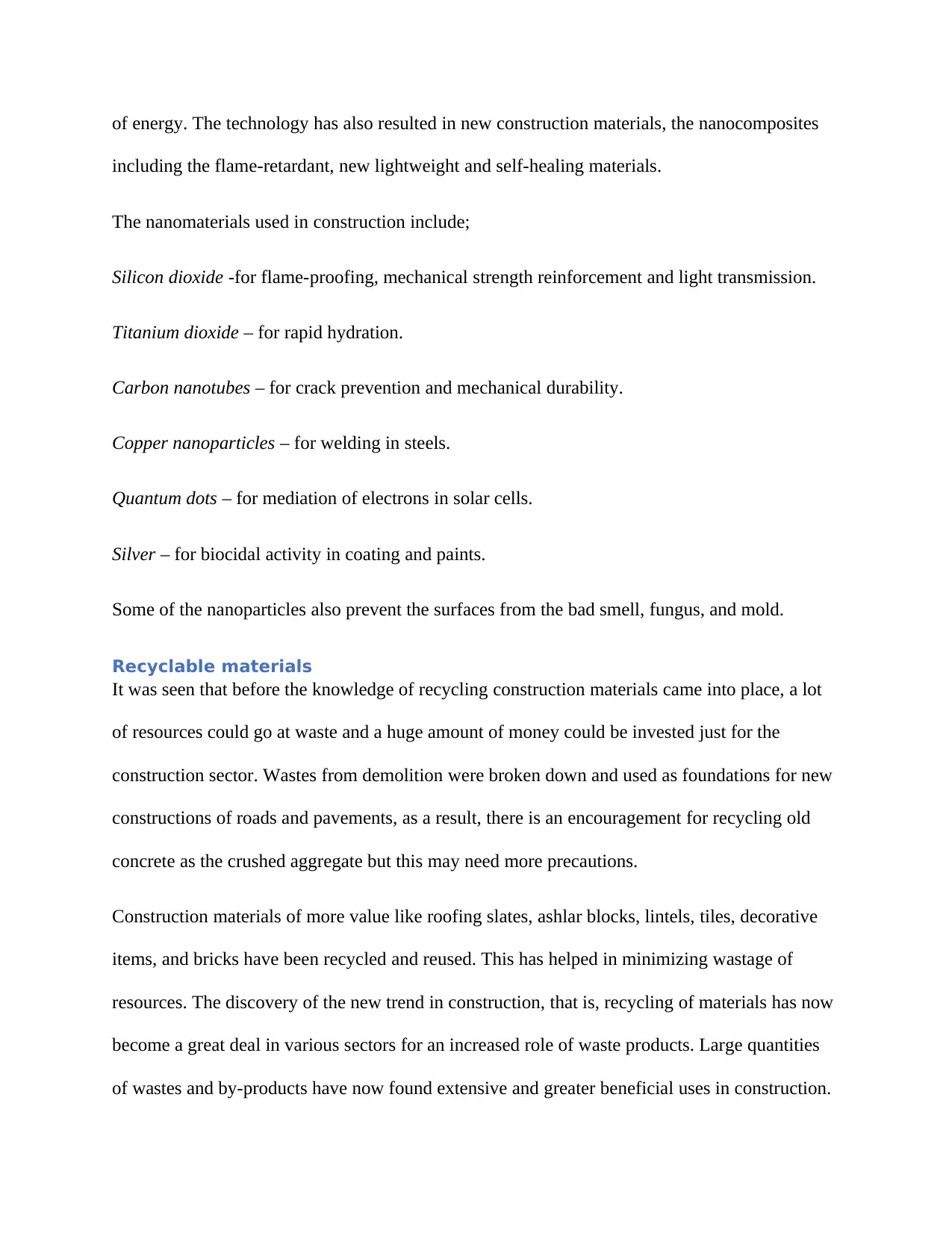
of energy. The technology has also resulted in new construction materials, the nanocomposites
including the flame-retardant, new lightweight and self-healing materials.
The nanomaterials used in construction include;
Silicon dioxide -for flame-proofing, mechanical strength reinforcement and light transmission.
Titanium dioxide – for rapid hydration.
Carbon nanotubes – for crack prevention and mechanical durability.
Copper nanoparticles – for welding in steels.
Quantum dots – for mediation of electrons in solar cells.
Silver – for biocidal activity in coating and paints.
Some of the nanoparticles also prevent the surfaces from the bad smell, fungus, and mold.
Recyclable materials
It was seen that before the knowledge of recycling construction materials came into place, a lot
of resources could go at waste and a huge amount of money could be invested just for the
construction sector. Wastes from demolition were broken down and used as foundations for new
constructions of roads and pavements, as a result, there is an encouragement for recycling old
concrete as the crushed aggregate but this may need more precautions.
Construction materials of more value like roofing slates, ashlar blocks, lintels, tiles, decorative
items, and bricks have been recycled and reused. This has helped in minimizing wastage of
resources. The discovery of the new trend in construction, that is, recycling of materials has now
become a great deal in various sectors for an increased role of waste products. Large quantities
of wastes and by-products have now found extensive and greater beneficial uses in construction.
including the flame-retardant, new lightweight and self-healing materials.
The nanomaterials used in construction include;
Silicon dioxide -for flame-proofing, mechanical strength reinforcement and light transmission.
Titanium dioxide – for rapid hydration.
Carbon nanotubes – for crack prevention and mechanical durability.
Copper nanoparticles – for welding in steels.
Quantum dots – for mediation of electrons in solar cells.
Silver – for biocidal activity in coating and paints.
Some of the nanoparticles also prevent the surfaces from the bad smell, fungus, and mold.
Recyclable materials
It was seen that before the knowledge of recycling construction materials came into place, a lot
of resources could go at waste and a huge amount of money could be invested just for the
construction sector. Wastes from demolition were broken down and used as foundations for new
constructions of roads and pavements, as a result, there is an encouragement for recycling old
concrete as the crushed aggregate but this may need more precautions.
Construction materials of more value like roofing slates, ashlar blocks, lintels, tiles, decorative
items, and bricks have been recycled and reused. This has helped in minimizing wastage of
resources. The discovery of the new trend in construction, that is, recycling of materials has now
become a great deal in various sectors for an increased role of waste products. Large quantities
of wastes and by-products have now found extensive and greater beneficial uses in construction.
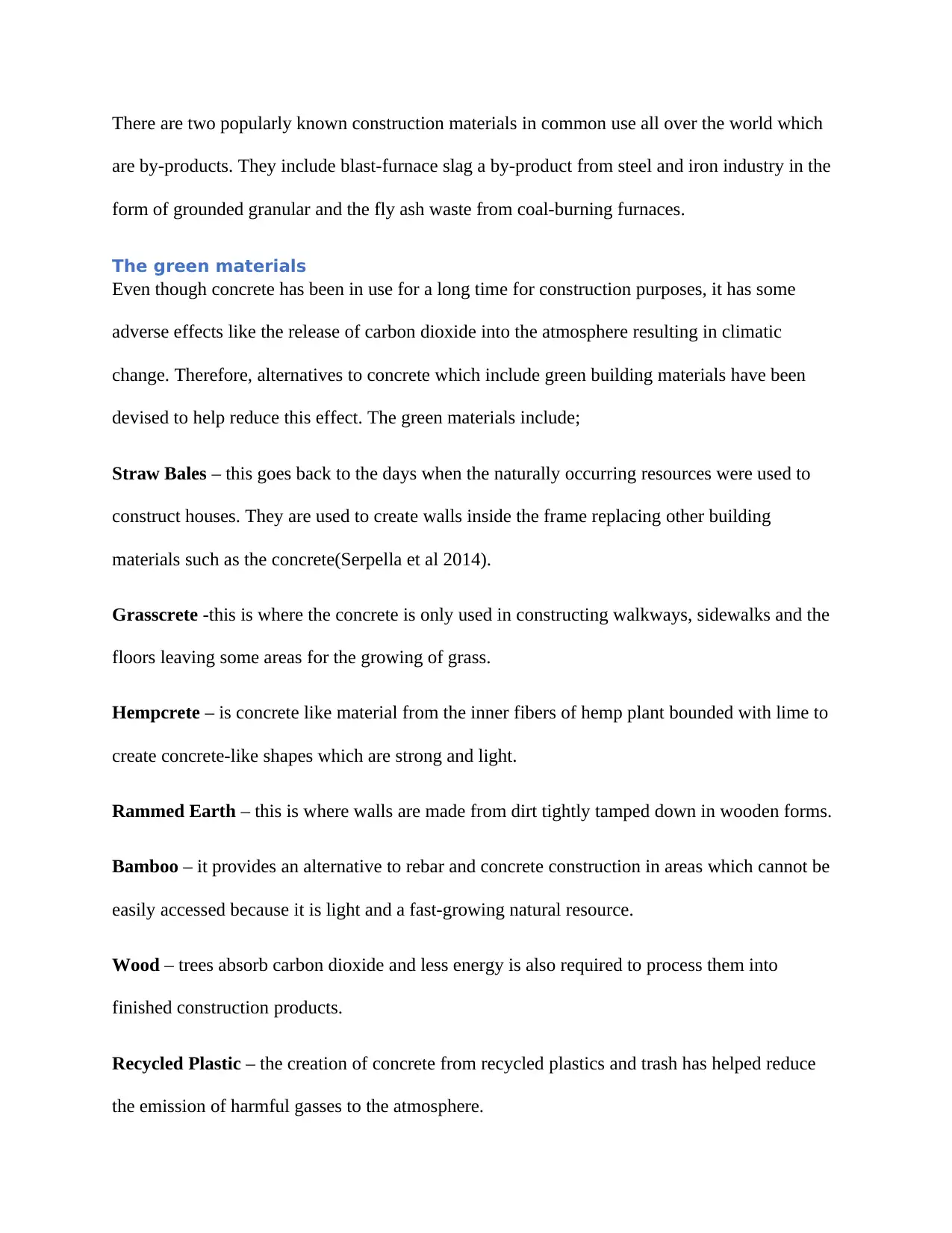
There are two popularly known construction materials in common use all over the world which
are by-products. They include blast-furnace slag a by-product from steel and iron industry in the
form of grounded granular and the fly ash waste from coal-burning furnaces.
The green materials
Even though concrete has been in use for a long time for construction purposes, it has some
adverse effects like the release of carbon dioxide into the atmosphere resulting in climatic
change. Therefore, alternatives to concrete which include green building materials have been
devised to help reduce this effect. The green materials include;
Straw Bales – this goes back to the days when the naturally occurring resources were used to
construct houses. They are used to create walls inside the frame replacing other building
materials such as the concrete(Serpella et al 2014).
Grasscrete -this is where the concrete is only used in constructing walkways, sidewalks and the
floors leaving some areas for the growing of grass.
Hempcrete – is concrete like material from the inner fibers of hemp plant bounded with lime to
create concrete-like shapes which are strong and light.
Rammed Earth – this is where walls are made from dirt tightly tamped down in wooden forms.
Bamboo – it provides an alternative to rebar and concrete construction in areas which cannot be
easily accessed because it is light and a fast-growing natural resource.
Wood – trees absorb carbon dioxide and less energy is also required to process them into
finished construction products.
Recycled Plastic – the creation of concrete from recycled plastics and trash has helped reduce
the emission of harmful gasses to the atmosphere.
are by-products. They include blast-furnace slag a by-product from steel and iron industry in the
form of grounded granular and the fly ash waste from coal-burning furnaces.
The green materials
Even though concrete has been in use for a long time for construction purposes, it has some
adverse effects like the release of carbon dioxide into the atmosphere resulting in climatic
change. Therefore, alternatives to concrete which include green building materials have been
devised to help reduce this effect. The green materials include;
Straw Bales – this goes back to the days when the naturally occurring resources were used to
construct houses. They are used to create walls inside the frame replacing other building
materials such as the concrete(Serpella et al 2014).
Grasscrete -this is where the concrete is only used in constructing walkways, sidewalks and the
floors leaving some areas for the growing of grass.
Hempcrete – is concrete like material from the inner fibers of hemp plant bounded with lime to
create concrete-like shapes which are strong and light.
Rammed Earth – this is where walls are made from dirt tightly tamped down in wooden forms.
Bamboo – it provides an alternative to rebar and concrete construction in areas which cannot be
easily accessed because it is light and a fast-growing natural resource.
Wood – trees absorb carbon dioxide and less energy is also required to process them into
finished construction products.
Recycled Plastic – the creation of concrete from recycled plastics and trash has helped reduce
the emission of harmful gasses to the atmosphere.
⊘ This is a preview!⊘
Do you want full access?
Subscribe today to unlock all pages.

Trusted by 1+ million students worldwide
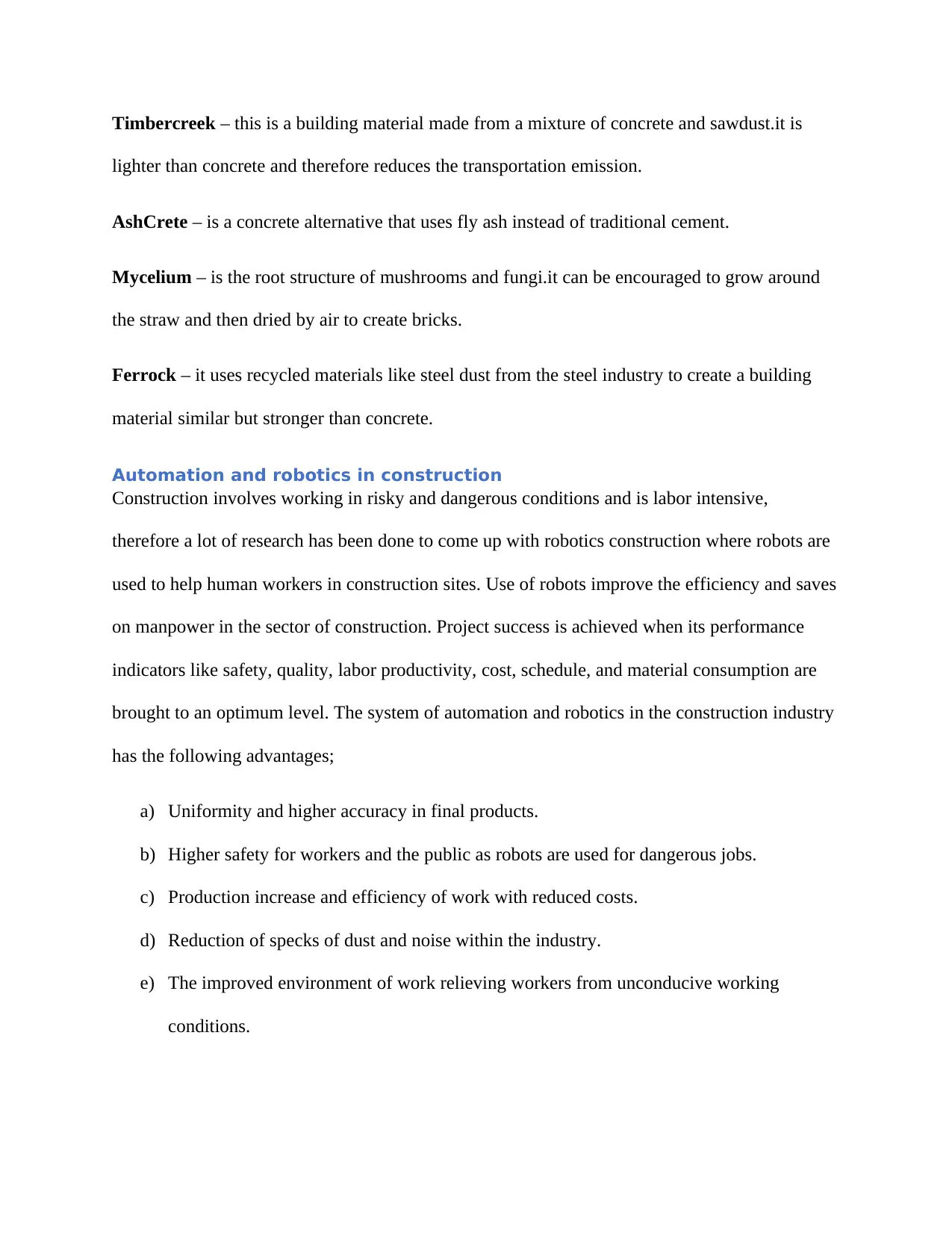
Timbercreek – this is a building material made from a mixture of concrete and sawdust.it is
lighter than concrete and therefore reduces the transportation emission.
AshCrete – is a concrete alternative that uses fly ash instead of traditional cement.
Mycelium – is the root structure of mushrooms and fungi.it can be encouraged to grow around
the straw and then dried by air to create bricks.
Ferrock – it uses recycled materials like steel dust from the steel industry to create a building
material similar but stronger than concrete.
Automation and robotics in construction
Construction involves working in risky and dangerous conditions and is labor intensive,
therefore a lot of research has been done to come up with robotics construction where robots are
used to help human workers in construction sites. Use of robots improve the efficiency and saves
on manpower in the sector of construction. Project success is achieved when its performance
indicators like safety, quality, labor productivity, cost, schedule, and material consumption are
brought to an optimum level. The system of automation and robotics in the construction industry
has the following advantages;
a) Uniformity and higher accuracy in final products.
b) Higher safety for workers and the public as robots are used for dangerous jobs.
c) Production increase and efficiency of work with reduced costs.
d) Reduction of specks of dust and noise within the industry.
e) The improved environment of work relieving workers from unconducive working
conditions.
lighter than concrete and therefore reduces the transportation emission.
AshCrete – is a concrete alternative that uses fly ash instead of traditional cement.
Mycelium – is the root structure of mushrooms and fungi.it can be encouraged to grow around
the straw and then dried by air to create bricks.
Ferrock – it uses recycled materials like steel dust from the steel industry to create a building
material similar but stronger than concrete.
Automation and robotics in construction
Construction involves working in risky and dangerous conditions and is labor intensive,
therefore a lot of research has been done to come up with robotics construction where robots are
used to help human workers in construction sites. Use of robots improve the efficiency and saves
on manpower in the sector of construction. Project success is achieved when its performance
indicators like safety, quality, labor productivity, cost, schedule, and material consumption are
brought to an optimum level. The system of automation and robotics in the construction industry
has the following advantages;
a) Uniformity and higher accuracy in final products.
b) Higher safety for workers and the public as robots are used for dangerous jobs.
c) Production increase and efficiency of work with reduced costs.
d) Reduction of specks of dust and noise within the industry.
e) The improved environment of work relieving workers from unconducive working
conditions.
Paraphrase This Document
Need a fresh take? Get an instant paraphrase of this document with our AI Paraphraser
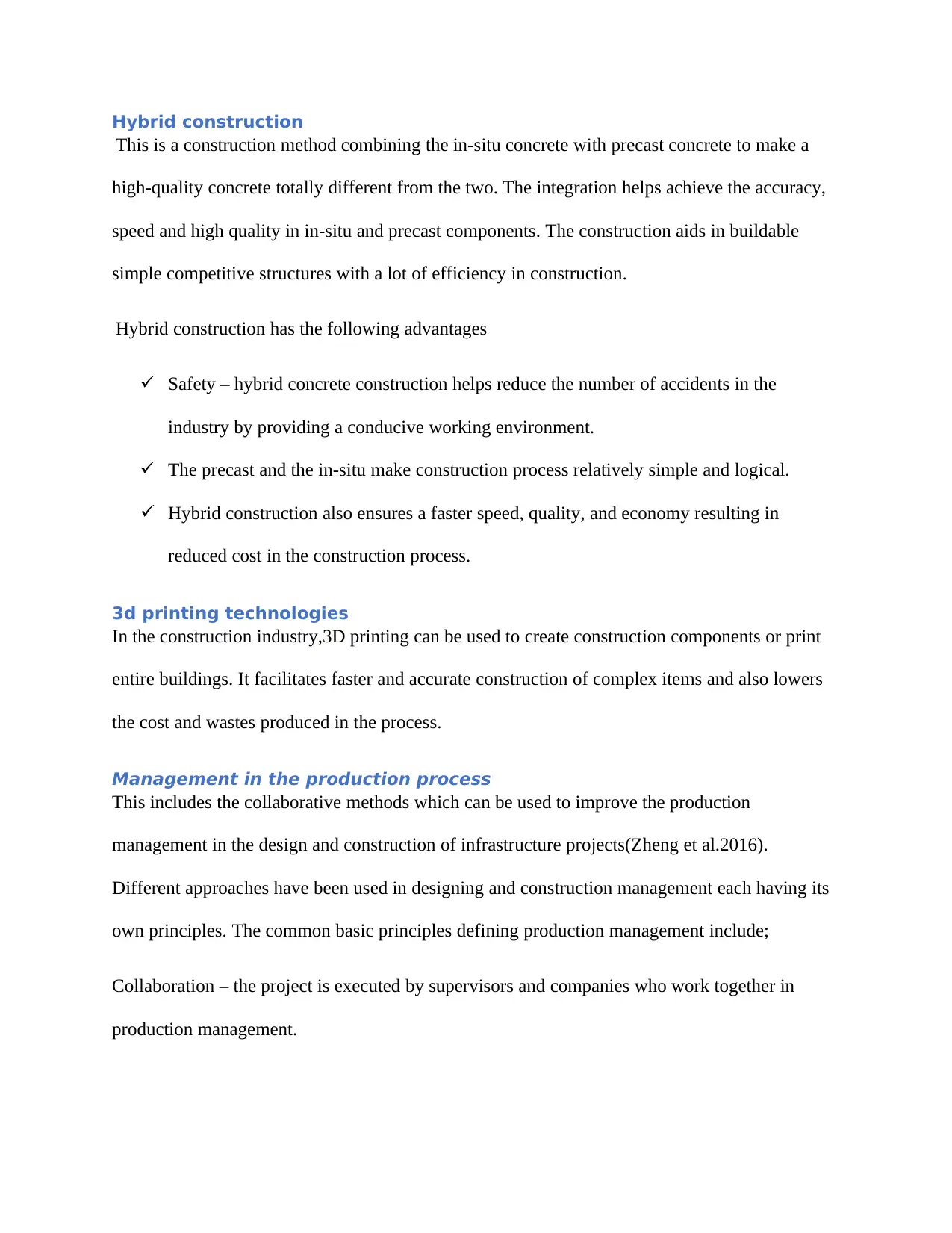
Hybrid construction
This is a construction method combining the in-situ concrete with precast concrete to make a
high-quality concrete totally different from the two. The integration helps achieve the accuracy,
speed and high quality in in-situ and precast components. The construction aids in buildable
simple competitive structures with a lot of efficiency in construction.
Hybrid construction has the following advantages
Safety – hybrid concrete construction helps reduce the number of accidents in the
industry by providing a conducive working environment.
The precast and the in-situ make construction process relatively simple and logical.
Hybrid construction also ensures a faster speed, quality, and economy resulting in
reduced cost in the construction process.
3d printing technologies
In the construction industry,3D printing can be used to create construction components or print
entire buildings. It facilitates faster and accurate construction of complex items and also lowers
the cost and wastes produced in the process.
Management in the production process
This includes the collaborative methods which can be used to improve the production
management in the design and construction of infrastructure projects(Zheng et al.2016).
Different approaches have been used in designing and construction management each having its
own principles. The common basic principles defining production management include;
Collaboration – the project is executed by supervisors and companies who work together in
production management.
This is a construction method combining the in-situ concrete with precast concrete to make a
high-quality concrete totally different from the two. The integration helps achieve the accuracy,
speed and high quality in in-situ and precast components. The construction aids in buildable
simple competitive structures with a lot of efficiency in construction.
Hybrid construction has the following advantages
Safety – hybrid concrete construction helps reduce the number of accidents in the
industry by providing a conducive working environment.
The precast and the in-situ make construction process relatively simple and logical.
Hybrid construction also ensures a faster speed, quality, and economy resulting in
reduced cost in the construction process.
3d printing technologies
In the construction industry,3D printing can be used to create construction components or print
entire buildings. It facilitates faster and accurate construction of complex items and also lowers
the cost and wastes produced in the process.
Management in the production process
This includes the collaborative methods which can be used to improve the production
management in the design and construction of infrastructure projects(Zheng et al.2016).
Different approaches have been used in designing and construction management each having its
own principles. The common basic principles defining production management include;
Collaboration – the project is executed by supervisors and companies who work together in
production management.

Transparency – the processes and final products from the production process should be made
aware to all the parties involved.
Improvement – it should involve the workforce in improving performance and problem-solving.
SUSTAINABLE DESIGN AND CONSTRUCTION
In order to improve the energy performance in a building in existence, the process of
refurbishment has been identified as one of the crucial technique to reduce the GHG as well as
combating climate change. There is however little that has been done to determine how the
behavior of human affects the solution selection of the refurbishment. This kind of problem is
obvious for the case of the high rise buildings found in the sub-tropical cities like the case of
Hong Kong(Yeheyis, et al 2013).
Acceptable Sustainable of refurbishment
The list shown below is a representation of a sample study in Hong Kong regarding sustainable
refurbishment.
Table 1: Energy measurement deliverables(Hwang and Ng 2013)
aware to all the parties involved.
Improvement – it should involve the workforce in improving performance and problem-solving.
SUSTAINABLE DESIGN AND CONSTRUCTION
In order to improve the energy performance in a building in existence, the process of
refurbishment has been identified as one of the crucial technique to reduce the GHG as well as
combating climate change. There is however little that has been done to determine how the
behavior of human affects the solution selection of the refurbishment. This kind of problem is
obvious for the case of the high rise buildings found in the sub-tropical cities like the case of
Hong Kong(Yeheyis, et al 2013).
Acceptable Sustainable of refurbishment
The list shown below is a representation of a sample study in Hong Kong regarding sustainable
refurbishment.
Table 1: Energy measurement deliverables(Hwang and Ng 2013)
⊘ This is a preview!⊘
Do you want full access?
Subscribe today to unlock all pages.

Trusted by 1+ million students worldwide
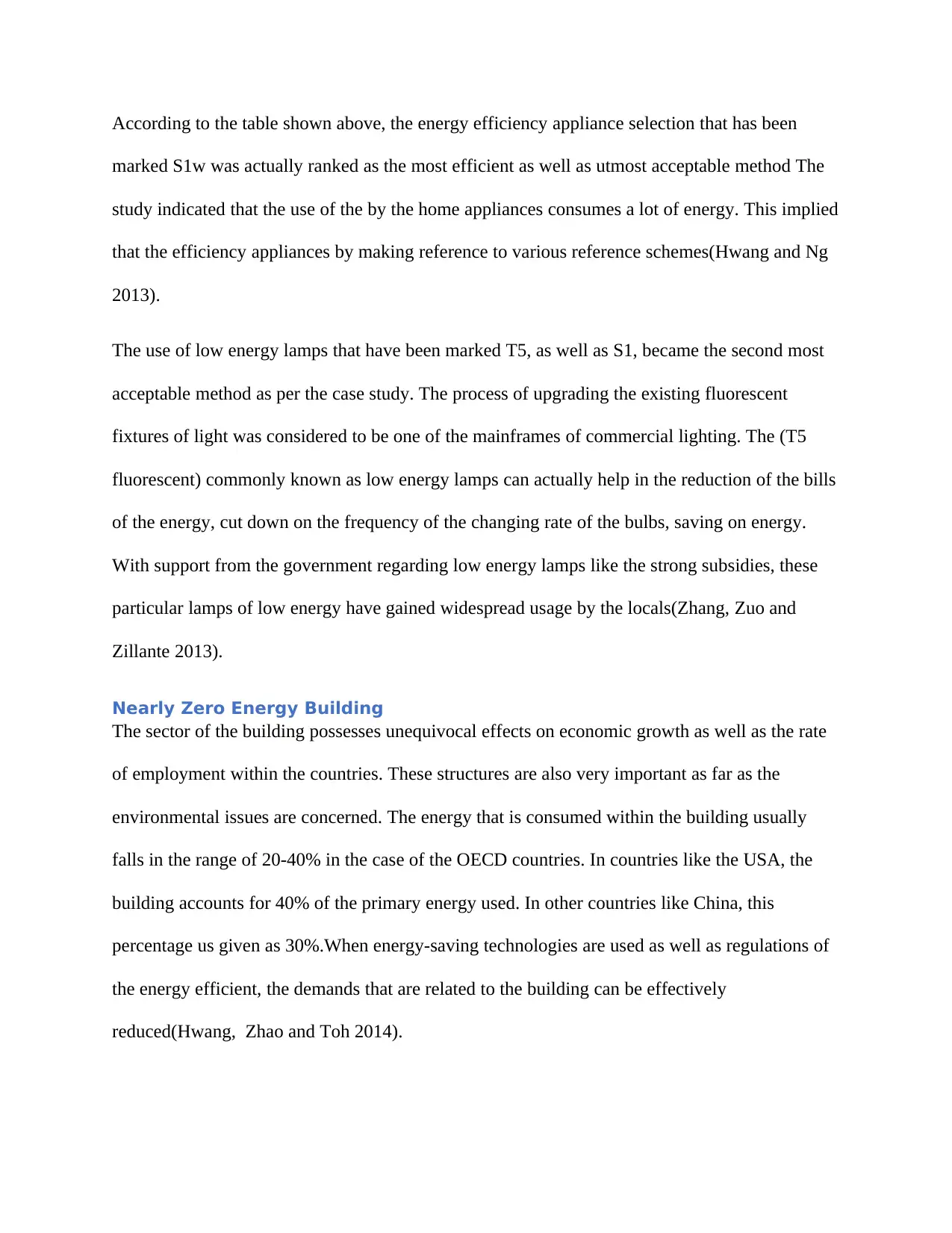
According to the table shown above, the energy efficiency appliance selection that has been
marked S1w was actually ranked as the most efficient as well as utmost acceptable method The
study indicated that the use of the by the home appliances consumes a lot of energy. This implied
that the efficiency appliances by making reference to various reference schemes(Hwang and Ng
2013).
The use of low energy lamps that have been marked T5, as well as S1, became the second most
acceptable method as per the case study. The process of upgrading the existing fluorescent
fixtures of light was considered to be one of the mainframes of commercial lighting. The (T5
fluorescent) commonly known as low energy lamps can actually help in the reduction of the bills
of the energy, cut down on the frequency of the changing rate of the bulbs, saving on energy.
With support from the government regarding low energy lamps like the strong subsidies, these
particular lamps of low energy have gained widespread usage by the locals(Zhang, Zuo and
Zillante 2013).
Nearly Zero Energy Building
The sector of the building possesses unequivocal effects on economic growth as well as the rate
of employment within the countries. These structures are also very important as far as the
environmental issues are concerned. The energy that is consumed within the building usually
falls in the range of 20-40% in the case of the OECD countries. In countries like the USA, the
building accounts for 40% of the primary energy used. In other countries like China, this
percentage us given as 30%.When energy-saving technologies are used as well as regulations of
the energy efficient, the demands that are related to the building can be effectively
reduced(Hwang, Zhao and Toh 2014).
marked S1w was actually ranked as the most efficient as well as utmost acceptable method The
study indicated that the use of the by the home appliances consumes a lot of energy. This implied
that the efficiency appliances by making reference to various reference schemes(Hwang and Ng
2013).
The use of low energy lamps that have been marked T5, as well as S1, became the second most
acceptable method as per the case study. The process of upgrading the existing fluorescent
fixtures of light was considered to be one of the mainframes of commercial lighting. The (T5
fluorescent) commonly known as low energy lamps can actually help in the reduction of the bills
of the energy, cut down on the frequency of the changing rate of the bulbs, saving on energy.
With support from the government regarding low energy lamps like the strong subsidies, these
particular lamps of low energy have gained widespread usage by the locals(Zhang, Zuo and
Zillante 2013).
Nearly Zero Energy Building
The sector of the building possesses unequivocal effects on economic growth as well as the rate
of employment within the countries. These structures are also very important as far as the
environmental issues are concerned. The energy that is consumed within the building usually
falls in the range of 20-40% in the case of the OECD countries. In countries like the USA, the
building accounts for 40% of the primary energy used. In other countries like China, this
percentage us given as 30%.When energy-saving technologies are used as well as regulations of
the energy efficient, the demands that are related to the building can be effectively
reduced(Hwang, Zhao and Toh 2014).
Paraphrase This Document
Need a fresh take? Get an instant paraphrase of this document with our AI Paraphraser

The idea of reducing the consumption of the energy in the building has led to the emergence of
the concept of the low energy building which is commonly referred to as the LEB. According to
the pioneer scholars on this particular concept, the ZEB concept does not need the extra energy
demand which is used for space cooling and space heating. It is therefore defined as a meeting of
the needs of energy from non-carbon emission generations of energy while at the same time
lowering bathe running as well as the installation cost(Mir and Pennington 2014).
Recycling building materials and components;
Recycling of the demolitions as well as the construction wastes materials that are generated at
the site of the construction in increasingly important. The benefits of environmental recycling are
very important. The present estimates have shown that if it would have been p[possible to
recycle all the asphalt as well as the concrete blocks that are produced from the countries like the
USA, the total energy saved would have been equivalent to the removal of 1 million cars from
the roads or saving 1 billion gallons of gasoline.
Besides saving on the energy used such initiatives of recycling helps to keep the materials out of
the landfills. Other than the environmental benefits that have been discussed in various sectors
above, this particular process has economic benefits. Most of the recyclers have started charging
for some percentage of money before they can accept the materials to be recycled. Recycling
thus reduces the cost of material disposal.
De-construction
The concept of de-construction should never be taken to mean demolition but instead, it should
be used to mean "breaking down" or analysis of something so as to get its true significance
which may not be exactly what had been intended by the researcher. It is possible for engineers
to deconstruct several myths in the construction industry. In the construction industry, the term
the concept of the low energy building which is commonly referred to as the LEB. According to
the pioneer scholars on this particular concept, the ZEB concept does not need the extra energy
demand which is used for space cooling and space heating. It is therefore defined as a meeting of
the needs of energy from non-carbon emission generations of energy while at the same time
lowering bathe running as well as the installation cost(Mir and Pennington 2014).
Recycling building materials and components;
Recycling of the demolitions as well as the construction wastes materials that are generated at
the site of the construction in increasingly important. The benefits of environmental recycling are
very important. The present estimates have shown that if it would have been p[possible to
recycle all the asphalt as well as the concrete blocks that are produced from the countries like the
USA, the total energy saved would have been equivalent to the removal of 1 million cars from
the roads or saving 1 billion gallons of gasoline.
Besides saving on the energy used such initiatives of recycling helps to keep the materials out of
the landfills. Other than the environmental benefits that have been discussed in various sectors
above, this particular process has economic benefits. Most of the recyclers have started charging
for some percentage of money before they can accept the materials to be recycled. Recycling
thus reduces the cost of material disposal.
De-construction
The concept of de-construction should never be taken to mean demolition but instead, it should
be used to mean "breaking down" or analysis of something so as to get its true significance
which may not be exactly what had been intended by the researcher. It is possible for engineers
to deconstruct several myths in the construction industry. In the construction industry, the term
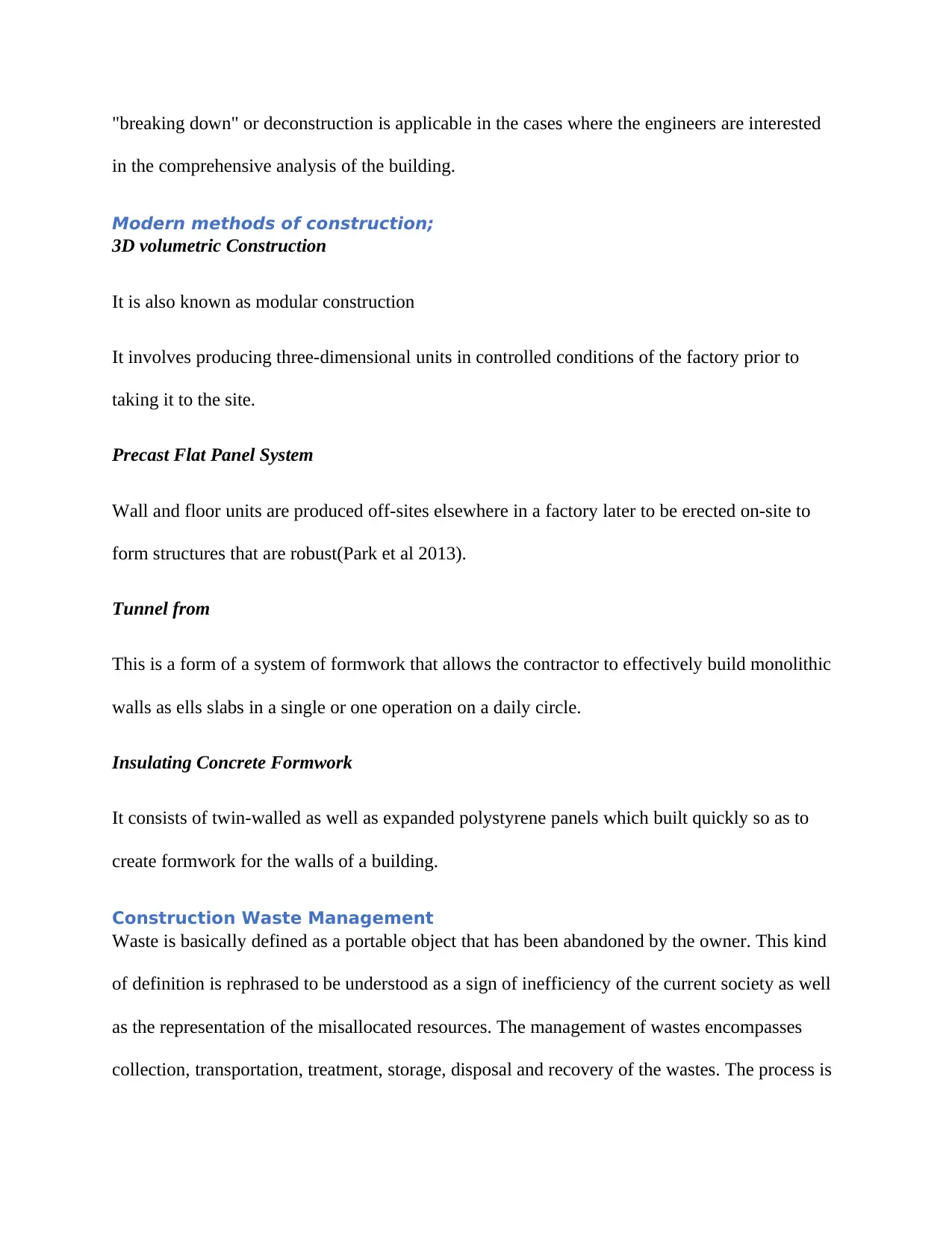
"breaking down" or deconstruction is applicable in the cases where the engineers are interested
in the comprehensive analysis of the building.
Modern methods of construction;
3D volumetric Construction
It is also known as modular construction
It involves producing three-dimensional units in controlled conditions of the factory prior to
taking it to the site.
Precast Flat Panel System
Wall and floor units are produced off-sites elsewhere in a factory later to be erected on-site to
form structures that are robust(Park et al 2013).
Tunnel from
This is a form of a system of formwork that allows the contractor to effectively build monolithic
walls as ells slabs in a single or one operation on a daily circle.
Insulating Concrete Formwork
It consists of twin-walled as well as expanded polystyrene panels which built quickly so as to
create formwork for the walls of a building.
Construction Waste Management
Waste is basically defined as a portable object that has been abandoned by the owner. This kind
of definition is rephrased to be understood as a sign of inefficiency of the current society as well
as the representation of the misallocated resources. The management of wastes encompasses
collection, transportation, treatment, storage, disposal and recovery of the wastes. The process is
in the comprehensive analysis of the building.
Modern methods of construction;
3D volumetric Construction
It is also known as modular construction
It involves producing three-dimensional units in controlled conditions of the factory prior to
taking it to the site.
Precast Flat Panel System
Wall and floor units are produced off-sites elsewhere in a factory later to be erected on-site to
form structures that are robust(Park et al 2013).
Tunnel from
This is a form of a system of formwork that allows the contractor to effectively build monolithic
walls as ells slabs in a single or one operation on a daily circle.
Insulating Concrete Formwork
It consists of twin-walled as well as expanded polystyrene panels which built quickly so as to
create formwork for the walls of a building.
Construction Waste Management
Waste is basically defined as a portable object that has been abandoned by the owner. This kind
of definition is rephrased to be understood as a sign of inefficiency of the current society as well
as the representation of the misallocated resources. The management of wastes encompasses
collection, transportation, treatment, storage, disposal and recovery of the wastes. The process is
⊘ This is a preview!⊘
Do you want full access?
Subscribe today to unlock all pages.

Trusted by 1+ million students worldwide
1 out of 29
Related Documents
Your All-in-One AI-Powered Toolkit for Academic Success.
+13062052269
info@desklib.com
Available 24*7 on WhatsApp / Email
![[object Object]](/_next/static/media/star-bottom.7253800d.svg)
Unlock your academic potential
Copyright © 2020–2025 A2Z Services. All Rights Reserved. Developed and managed by ZUCOL.





